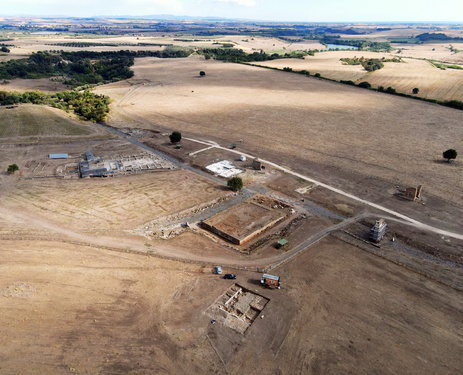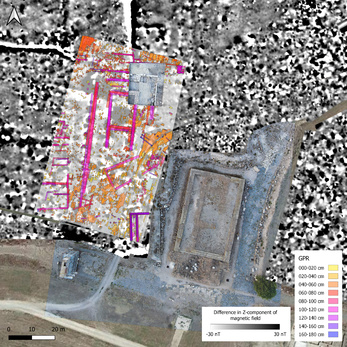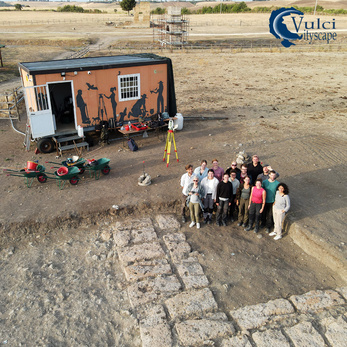Die Cityscape Vulcis vor dem neuen Tempel. Frühe Urbanisierungsprozesse einer etruskischen Metropolis
 Panorama of the Vulci plateau, facing south, in the foreground the excavation trench and the tempio grande
Panorama of the Vulci plateau, facing south, in the foreground the excavation trench and the tempio grande(translated project title)
Less than ten kilometres from the Tyrrhenian Sea on the right bank of the River Fiora up on a raised plateau lies Vulci – one of the 12 cities of the Etruscan League and in pre-Roman times one of the most important urban centres on the Italian peninsula. The city’s necropolises have, since the first excavations back in 1828, provided rich testimony to their historical, political and economic importance and paint the picture of a city at the very heart of far-reaching Mediterranean networks.
Since 2020, archaeologists Dr Mariachiara Franceschini and Dr Paul Pasieka have in their “Vulci Cityscape” project been studying the city across a larger area and thus over and above the limits of the necropolis and surface finds. The traces of settlements that go back to the very early days of the city are expected to provide invaluable information on the urbanization process and the different phases in the development of the city. For their work, the archaeologists used geomagnetic prospecting and soil investigations by means of a ground radar and in this way discovered a monumental temple north of the decumanus, the city’s main street. The new find was sized about 40 × 27 metres, and therefore has almost the same dimensions as the tempio grande discovered back in the 1950s and which was hitherto assumed to be the city’s main temple. An Etruscan city with two main temples would be a remarkable matter. And things don’t stop there as an additional building sized 22 × 13 metres was also unearthed and it was likewise reserved for public, cultic activities. Vulci, or so the results to date indicate, evidently had a veritable religious quarter.
 Geomagnetic and GPR interpretation with georeferenced orthophoto of the excavation trench and the surroundings with the tempio grande
Geomagnetic and GPR interpretation with georeferenced orthophoto of the excavation trench and the surroundings with the tempio grande The 2022 research team
The 2022 research teamOn the basis of the results of pre-excavations carried out in 2021 with a grant from the Fritz Thyssen Foundation, in the year under review the archaeologists started an excavation series in order to study the early phases of Vulci using a focused, high-resolution excavated section. The construction of the new temple in the Late Archaic period provided a secure terminus ante quem at the end of the 6th century BCE for the strata lying below it. A large amount of roof terracotta was used as filler material for the building work and together with the other finds points to the site being used for religious purposes before the construction of the temple itself. The filler shards include panelling with figurative decorations that must have belonged to earlier monumental buildings. The excavation was conducted over large enough an area to allow an examination of how the cliff had been cut away. Of particular interest in this context was whether the cliff had been cut to form pieces that could be combined to render larger structures and whether for example they belonged to buildings made of impermanent materials such as huts. Taken together, this information provides an indication of how exactly the site’s use evolved.
The excavation contributed significantly to answering questions on how cities evolved in Etruria, with reference to the example of Vulci. It expanded our understanding of the architectural forms of the Early Iron Age and/or the Orientalizing Age, above all the formation of public-religious areas as key stages in the emergence of Etruscan society. The results of the project will be presented at the “Vulci. Work in Progress 2” convention in spring 2023 and initially published as a preliminary report in the convention proceedings.
Project leadership
Dr. Mariachiara Franceschini
Dr. Paul Pasieka
Institutions
Albert-Ludwigs-Universität Freiburg
Johannes Gutenberg-Universität Mainz
Support
The Gerda Henkel Foundation supported the project by covering personnel, travel and material costs.
This project was documented in spring 2023.

